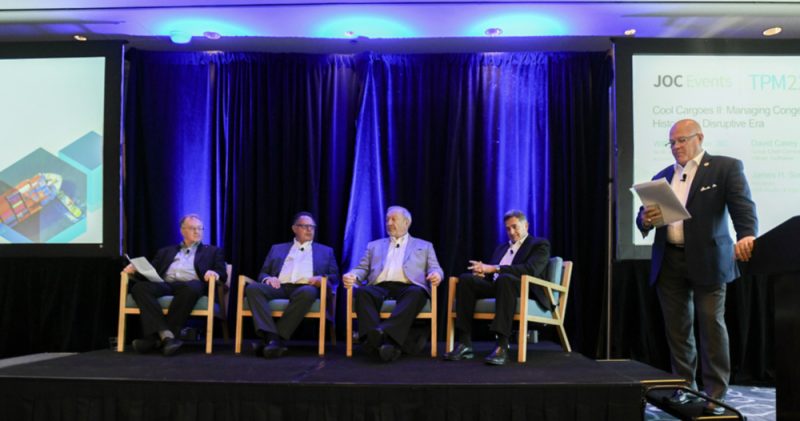{:en}Sharjah, United Arab Emirates:
Relentless port congestion and rising freight costs are impacting heavily on global supply chains, with major disruption encountered in sectors such as fast-moving consumer goods, pharmaceutical and agricultural exports. The focus on larger container vessels serving a dwindling number of mega ports has limited the choices of shippers and receivers and created a rush to ship through traditional major gateway ports, leading to backlogs and displaced containers.

“There needs to be an effort to de-centralize cargo movement or at least reconsider the speed with which industry appears to be centralizing the distribution of goods”, Dave Casey, Group Chief Commercial Officer at Gulftainer, told industry leaders during a Cool Cargoes webcast discussing ‘Managing Congestion in a Relentlessly Disruptive Era’.
Casey, told a panel of industry leaders that whilst larger ports are buckling under the pressure of high levels of congestion, facilities that can handle smaller container ships and general-purpose ships, those such as Hueneme, San Diego, Wilmington, DE and Canaveral FL are generally congestion-free.
Major U.S. retailers and midsized companies have seized the opportunity to charter conventional vessels and explore an alternative to hub ports in their quest to regain control over distribution channels. However, one such area proving problematic is refrigeration containers, which are costing shippers billions of dollars. The global shortage of reefer containers has impacted perishable imports, which due to the seasonal nature of these refrigerated commodities, further exacerbate congestion, as Casey explained: “The condensed nature of certain products such as grapes and clementines leads to more pressure. Many of the ports where fruits and vegetables originate from, such as South Africa, Chile and Morocco, are much smaller with less sophisticated infrastructure than Asia, North America and some European ports. In the event there is a delay or port omission, this can further exacerbate the congestion.” This delay is currently evident in the main ports in Chile, which are congested and are giving priority to container vessels. “The conventional reefer ships that carry the majority of GTW’s fruit from Chile are being forced to load at alternate and multiple ports, which will cause difficulties for exporters and growers to get their products to market on time.”
With many stakeholders involved in the sea cargo supply chain, it is difficult to ascertain where the responsibility for control sits. Traders, shipping lines, drivers, feeder vessels and government departments all have a part to play to help reduce an already struggling system, as Casey said, “Shippers need to maintain a degree of flexibility over origin sailings, and by tightly controlling and prioritizing cargo, efficiently handling customs clearance documentation and payment this will give importers the best opportunity to release and advance cargo through the networks.”
Shipping is an industry that is already embracing digitization and Gulftainer remains at the forefront having been awarded the 2021 CXO Middle East award for the ‘Future of Ports’ which yielded four innovative ideas to transform the Maritime sector. Neutral providers like Project 44 continue to develop tech-solutions to provide valuable real-time visibility insights to shippers, carriers and logistics providers. Advent-E Modal, near dock drop yards and 24-7 operations prove that automation and the drive towards digital technology will continue to improve operational performance.
“Technology needs to be leveraged but more importantly, it needs to enable the correct business processes”, concluded Casey.
{:}{:ar}الشارقة، الإمارات العربية المتحدة ,
(“ايتوس واير”) يؤثر ازدحام الموانئ الذي لا هوادة فيه وارتفاع تكاليف الشحن تأثيراً شديداً على سلاسل الإمداد العالمية، مع حدوث اضطراب كبير في قطاعات عدة، مثل السلع الاستهلاكية السريعة الحركة، والصادرات الصيدلانية والزراعية، وغيرها، وأدى التركيز على سفن الحاويات الأكبر حجماً التي تخدم عدداً متناقصاً من الموانئ الضخمة إلى الحد من خيارات الشاحنين، وخلق اندفاعاً لشحن موانئ العبور الرئيسية التقليدية، ما أدى إلى تراكم الأعمال المتراكمة وإزاحة الحاويات.
وقال ديفد كيسي، الرئيس التجاري للمجموعة في غلفتينر، لقادة الصناعة خلال مؤتمر كول كارغو الذي يناقش “إدارة الازدحام في عصر مدمر “، يجب بذل الجهود لإضفاء الطابع المركزي على حركة البضائع أو على الأقل إعادة النظر في السرعة التي يبدو بها أن الصناعة تركز على توزيع البضائع”.

وأوضح كيسي بأن تجار التجزئة الرئيسيون والشركات متوسطة الحجم اغتنموا الفرصة لاستئجار السفن التقليدية واستكشاف بديل للموانئ المحورية، في سعيهم لاستعادة السيطرة على قنوات التوزيع، ومع ذلك، فإن حاويات التبريد، التي تكلف الشاحنين بلايين الدولارات، هي أحد هذه المجالات التي تثبت أنها إشكالية، وقد أثر النقص العالمي في حاويات التبريد على الواردات القابلة للتلف، والتي بسبب الطبيعة الموسمية لهذه السلع المبردة، تزيد من تفاقم الازدحام.
وتابع: إن الطبيعة المكثفة لبعض المنتجات مثل العنب والليمون وغيرهما تؤدي إلى المزيد من الضغط، كما أن العديد من الموانئ التي تتوافر فيها الفواكه والخضروات، مثل جنوب أفريقيا وتشيلي والمغرب، أصغر بكثير من حيث البنية التحتية الأقل تطوراً من آسيا وأمريكا الشمالية وبعض الموانئ الأوروبية، وفي حالة حدوث تأخير أو إغفال في الميناء، يمكن أن يؤدي ذلك إلى تفاقم الازدحام، ويتضح هذا التأخير حالياً في الموانئ الرئيسية في تشيلي، المكتظة، والتي تعطي الأولوية لسفن الحاويات.
ولفت إلى أن السفن التقليدية التي تحمل معظم ثمار التوت الأزرق، العنب، البرقوق، التفاح المجفف، والخوخ)، وغيرها، من شيلي مضطرة للتحميل في موانئ بديلة ومتعددة، ما يسبب صعوبات للمصدرين والمزارعين للحصول على منتجاتهم في الوقت المناسب.
وشرح بأنه مع وجود العديد من الاطراف في سلسلة توريد البضائع البحرية، من الصعب التأكد من مكان المسؤولية عن الرقابة، كما أن التجار وخطوط الشحن والسائقين وسفن التغذية والإدارات الحكومية لديهم دور يلعبونه للمساعدة في تقليل النظام المتعثر بالفعل.
وتابع: يحتاج الشاحنون إلى الحفاظ على درجة من المرونة على الإبحار الأصلي، ومن خلال التحكم الصارم في البضائع وتحديد أولوياتها، والتعامل بكفاءة مع وثائق التخليص الجمركي والدفع، ما سيمنح المستوردين أفضل فرصة للإفراج عن البضائع وتقديمها عبر الشبكات.
وأشار إلى أن صناعة الشحن الرقمية حاضرة بقوة في غلفتينر التي أصبحت في موقع ريادي بعد أن حصلت على جائزة CXO الشرق الأوسط 2021 لـ “مستقبل الموانئ” التي أنتجت أربع أفكار مبتكرة لتحويل القطاع البحري، ويواصل مقدمو الخدمات المحايدون مثل المشروع 44 تطوير الحلول التقنية لتوفير رؤى قيمة في الوقت الحقيقي للشاحنين والناقلين ومقدمي الخدمات اللوجستية، وتثبت عمليات “آدفنت إيه مودال”، وقرب أحواض الرسو، ومختلف العمليات التي تتم على مدار الساعة، أن الأتمتة والتحرك نحو التكنولوجيا الرقمية سيستمران في تحسين الأداء التشغيلي.
وأكد أن التكنولوجيا تحتاج إلى تعزيز، ولكن الأهم من ذلك أنها تحتاج إلى تمكين العمليات التجارية الصحيحة.
* المصدر: “ايتوس واير”{:}














